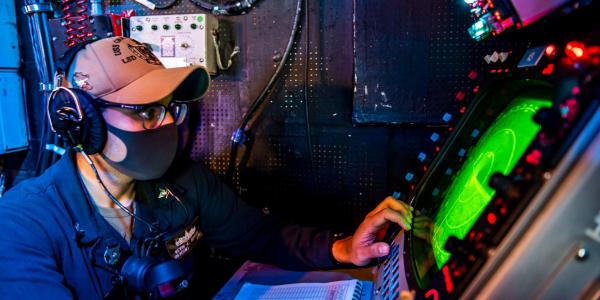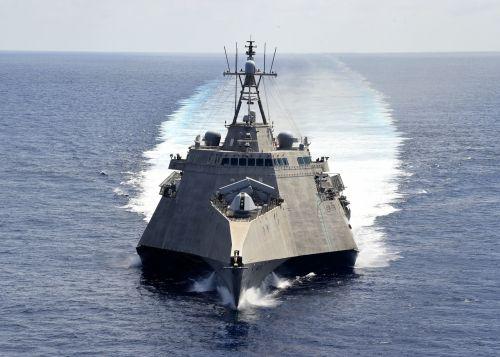The Navy Goes Parallel With New Digital Capabilities
The U.S. Navy is focusing on parallel development of its new digital assets and capabilities as it works to rush advanced information innovations to the fleet. With the need for better technologies increasing coincidental to the rapidly evolving threat picture, the Navy has opted for concurrence as its main tool for implementing both upgrades and innovations.
Shortening the timeline for deployment has become more important as technologies evolve more quickly and adversaries become increasingly capable as they target U.S. command, control, communications, computers and intelligence (C4I) systems. Instead of sequentially moving forward with different disciplines such as design, training, logistics and deployment, the U.S. Navy is taking a different look at how it fields digital systems with an eye toward concurrency.
Rear Adm. Kurt J. Rothenhaus, USN, program executive officer (PEO) C4I and Space Systems, describes this approach as viewing through the prism of digitization. While digitization may be a priority, he relates that it has many different factors. Some are technological, but others involve leveraging the tools that are coming out of the commercial sector and other partners. He calls for applying the digitization prism to everything the PEO is doing—“looking at things that used to be somewhat serial and do them in parallel,” he says.
The admiral continues that model-based system engineering and the digital twin effort feed into the ability to work all aspects of capability in parallel. The result is a simultaneous opportunity to field a system and have sailors trained to operate it on procedures already in place. Many of the systems the PEO delivers work across the broad spectrum of capabilities, the admiral adds.
As an example, he cites the Consolidated Afloat Network Enterprise Services (CANES), where one of the central tenets was to design the system concurrently with the training materials and the logistics work for it. Now, by leveraging partners’ technologies, the PEO can synchronize the effort as a workforce.
“The digitization prism is really a game changer,” he maintains.
Adm. Rothenhaus lauds the close relationship the PEO has with the commercial information technology sector. “One of the strengths of the organization is the ability to take that significant investment of the commercial sector and bring those tools and capabilities and optimize them to be successful in Navy needs,” he declares. The PEO has enduring partnerships with traditional defense partners, but it also has developed deep relationships with companies that deliver services primarily to the commercial marketplace.
The PEO will be increasing its work with industry in software, he continues. Ensuring the fleet maintains connectivity is one of the core focus areas, he says. Delivering software capabilities more rapidly to common platforms is a key part of that. This includes having commercial talent work with the Navy on some of its most challenging problems. It has used methods such as other transactional authorities (OTAs) to facilitate access to skilled workers who traditionally have not worked on defense systems, he adds.
The admiral identifies several familiar technologies as key enablers for the PEO. These include software-defined networking, artificial intelligence and machine learning, and he notes that the PEO already is delivering capabilities that leverage machine learning. Autonomy will play a large role in the Navy’s future, along with support to unmanned systems. “Unmanned systems are technology opportunity that we are really excited to support,” he adds.
New technologies in the delivery of software systems would help the Navy update on the move, the admiral notes. Describing these as “really compelling parts of the architecture,” he explains that having the capacity to redefine and rapidly change software while operating allows the Navy to deliver new capabilities to the fleet more seamlessly.
Again, many of these efforts will build on commercial advances. “There isn’t an area of our business or our mission that isn’t undergoing some pretty dramatic technological change,” Adm. Rothenhaus says.
The other services also play a role in the PEO’s advances. The admiral notes that C4I and space systems are joint capabilities by their nature. In command and control (C2), the PEO provides expeditionary C2 systems and capabilities that allow the standup of joint task forces as required by combatant commanders, the admiral offers. The PEO partners with allies and coalition partners on technology and capabilities, he adds.
The ocean-based force provides some unique challenges, the admiral allows. The fleet operates in a way that is “very disconnected” at times, and it must be successful on ships and submarines. These systems can constitute the strategic high ground, but they are more difficult to engineer and support. These complex challenges tend to be inherent to the nature of the Navy and its mission, he adds.
Potential adversaries have been improving in areas where the Navy historically has had a comfortable lead, Adm. Rothenhaus states. Ironically, one asset poses a harder challenge to meet: the use of commercial systems. As advanced as they are, these technologies—particularly their fundamental underpinnings—are available to the adversaries as well. As a result, the Navy must work harder to overcome these commercially available capabilities.
The admiral states that the PEO is striving both to stay ahead of enemy capabilities and to push them back. “It is a really dynamic tension in push and pull,” he says. In some specific areas, such as satellite communications, efforts largely focus on maintaining connectivity in a contested environment. But the PEO also wants to build into the systems that ride networks a capacity to be smart enough to manage and operate through a disconnected environment. “Our objective here is to build systems that allow the commander the maximum amount of flexibility to flow between those two approaches,” he declares.
Cyber resilience is a major concern for the PEO, and Adm. Rothenhaus divides efforts into two categories. One is a focus on the fleet sailor, in particular how the PEO supports enlisted ratings that perform operation and maintenance. “We really view those folks in a lot of ways as our North Star,” he states. “A big part of cyber resilience is making sure they have the tools they need to be successful—to not only maintain the system, but organically cyber defend it, have the tools to monitor and have a sense of baseline, and really be masters of the system.” This entails providing training, technical documentation, procedures and access to innovative materials such as interactive technology manuals, he continues.
“A lot of what we’re doing is to really build that connecting tissue with the sailor who’s operating [with the system developers],” Adm. Rothenhaus says. “We’re capturing those lower-level lessons learned, and we can get those fixes rapidly back out to them and build that capacity with the sailors understanding the challenges that they’re facing.”
The admiral allows that being able to provide threat-based solutions to the fleet is at the core of the PEO’s efforts, as well as its metric for accomplishment. “We see ourselves as enablers for the heroes that take these systems out to sea,” he says. “We really are focused on unmanned systems and supporting those emerging technologies so that they can all fit seamlessly in a future naval tactical grid.
“We’ll know when we are successful when the fleet is successful on its own without a lot of help from the shore in getting its mission done and keeping these systems up and operational,” he warrants. “We are winning, and we’ll know we’re getting better when we see those sailors out at sea, finding issues and correcting them and being successful with the systems and keeping them up and operational, and supporting the warfighting objectives their commanders have given them.
“We’ll know we’re successful when we’re even more able to rapidly update the system to pivot to the requirements the commanders have placed on the system—that they learned something new about the adversary, they were able to give us that feedback, and we were quickly able to go, ‘Yes, here’s a change to that system, now it’s back in your hand,’ and define that in not years or months but days and even hours,” he declares.
“If AI, SIGINT, C2, intelligence software, networking and RF transport communications areas all can be agile and rapid and responsive, and the sailors are able to be successful with the systems, then I’ll know we did our job well.”







Comments